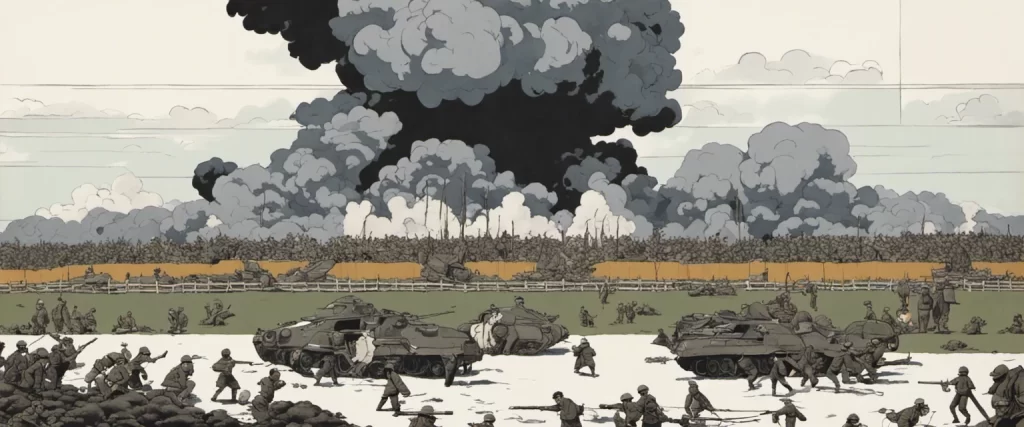—The Rape of Nanking & Tennozan
In the realms of historical literature, certain events, without fail, gravitate towards our collective consciousness, leaving indelible imprints on our understanding of the human condition. The Rape of Nanking, written by Iris Chang, and Tennozan: The Battle of Okinawa and the Atomic Bomb, penned by George Feifer, undoubtedly fall within this extraordinary category. Examining two distinct yet interconnected episodes from World War II, these two masterpieces shed light on the tragic experiences endured by the victims while offering profound insights into the complexities of human conflict.
Iris Chang’s The Rape of Nanking presents a harrowing account of one of the most horrifying atrocities in modern history – the ruthlessness with which the Imperial Japanese Army pillaged, raped, and massacred countless innocent Chinese civilians during the occupation of Nanking (now Nanjing) in 1937. Through meticulous research and compelling storytelling, Chang not only exposes the extent of the brutality, but also reveals the longstanding impact on the survivors and the struggle for justice. By juxtaposing personal narratives of victims with official records and testimonies, she paints a haunting picture of human suffering and resistance that is hard to ignore.
In parallel, George Feifer’s Tennozan explores the pinnacle of the Pacific War, the Battle of Okinawa, and its cataclysmic end with the deployment of the atomic bomb, ushering in a new age of warfare. With a keen eye for detail, Feifer delves into the strategic significance of Okinawa, the military tactics employed, and the stoic determination of both American and Japanese forces. Amidst the raging battlefield, Feifer also illuminates the experiences of common soldiers and civilians caught in the crossfire, showcasing the human dimensions of a conflict overshadowed by the fateful decision to unleash the atomic bomb.
While The Rape of Nanking and Tennozan explore two distinct wartime episodes, they converge in their exploration of the human capacity for violence, resilience, and the pursuit of justice. Chang’s work centers on shedding light on a forgotten atrocity, acts that were systematically denied and concealed, while Feifer’s book unearths the grand scale and ramifications of warfare culminating in the use of destructive new technology. Both authors provoke introspection into the consequences of war on individuals and societies, raising profound questions about accountability, memory, and the potential for healing and reconciliation.
This comparative study aims to examine the unique perspectives and narratives offered by Chang and Feifer, elucidating the subtle differences in their approaches, methodologies, and insights. By analyzing the historical contexts, narrative strategies, and the emotional resonance of these two works, we seek to gain a more nuanced understanding of these pivotal moments in history, as well as the lasting legacy they have left on the collective memory of our global society.
Brief Summary of Two Books
The Rape of Nanking by Iris Chang
“The Rape of Nanking” by Iris Chang is a non-fiction book that sheds light on the 1937-1938 Nanking Massacre, during which Japanese forces invaded the Chinese city of Nanking (now Nanjing) and committed horrendous acts of violence against its inhabitants. Chang extensively researched historical records, eyewitness accounts, and survivor testimonies to document the atrocities that took place. The book discusses the mass killings, systemic rape, torture, looting, and destruction that occurred over a six-week period, resulting in the deaths of hundreds of thousands of people. Chang also examines the aftermath of the massacre, the denial and attempts to cover up the events, and the psychological impact on survivors. Through detailed storytelling, “The Rape of Nanking” serves as a brutal reminder of the horrors of war and the importance of acknowledging historical atrocities.
Tennozan by George Feifer
Tennozan” by George Feifer is a historical non-fiction book that delves into the intense Battle of Okinawa during World War II and its connection to the deployment of the atomic bomb. The book provides a comprehensive account of the battle, highlighting the significant role played by the Japanese Emperor Hirohito, who was worshipped as a god-like figure by his subjects. Feifer examines the motivations and strategies of both the Japanese and American forces, emphasizing the brutal nature of the conflict and the heavy casualties suffered by both sides. Furthermore, the book explores the decision-making process behind the United States’ controversial choice to drop the atomic bomb, including the debates within the American government and the belief that it could finally force Japan’s surrender. Overall, “Tennozan” probes the complexities and consequences of the Battle of Okinawa, shedding light on a crucial period in history that shaped the end of World War II.
Comparison between Two Books

Similarities in Nanking Massacre
Both “The Rape of Nanking” by Iris Chang and “Tennozan” by George Feifer contain accounts and discussions about the Nanking Massacre during World War II. The books explore different aspects of the event, but there are some similarities that emerge from their narratives:
1. Historical Context: Both books provide a historical background to help readers understand the events leading up to the Nanking Massacre. They discuss the Japanese invasion of China, the battles preceding the occupation of Nanking, and the broader socio-political atmosphere of the time.
2. Eyewitness Accounts: To depict the horrific nature of the Nanking Massacre, both authors heavily rely on first-hand testimonies and personal accounts. They incorporate the voices of survivors, foreign witnesses, and soldiers involved in the events, allowing readers to grasp the atrocities committed during the massacre.
3. Documentation of Atrocities: Both works meticulously document the extreme violence and cruelty that occurred during the Nanking Massacre. Chang and Feifer both detail acts of rape, murder, torture, looting, and arson committed by Japanese soldiers against Chinese civilians, as well as the specific targeting of women and children.
4. Impact on the Chinese Population: Both books discuss the profound psychological and societal impacts of the Nanking Massacre on the Chinese population. They delve into the emotional trauma experienced by survivors, the disruption of families and communities, and the long-term effects on Chinese society as a whole.
5. International Response: Chang and Feifer explore the international response to the Nanking Massacre. They discuss the efforts of foreign diplomats, missionaries, and journalists to document and publicize the events in Nanking, as well as the political challenges in holding Japanese war criminals accountable.
6. Historical Controversies: Both authors address controversies and debates surrounding the Nanking Massacre. They discuss denial and revisionist arguments, examine Japanese apologies and the politics of memory, and analyze the historical significance of the Nanking Massacre in the context of World War II atrocities.
While the focus of “The Rape of Nanking” is primarily on the Nanking Massacre itself, and “Tennozan” encompasses the broader Battle of Okinawa and the atomic bomb, these books share common ground in their exploration of the Nanking Massacre and its impact on history.
Divergences in Nanking Massacre
Both The Rape of Nanking by Iris Chang and Tennozan: The Battle of Okinawa and the Atomic Bomb by George Feifer provide historical accounts of significant events during World War II. While both books discuss different aspects of the war, they diverge in their focus on the Nanking Massacre.
The Rape of Nanking by Iris Chang extensively documents the atrocities committed by the Imperial Japanese Army during the invasion and occupation of Nanking (now Nanjing), China, in 1937. Chang meticulously recounts the brutal violence against Chinese civilians and captured soldiers, including mass killings, rape, looting, and systematic destruction. She relies on primary sources, survivor testimonies, and eyewitness accounts to paint a vivid picture of the horrors endured by the city’s inhabitants. Chang’s book aims to expose the long-suppressed historical truth of the Nanking Massacre and give voice to its victims.
In contrast, Tennozan: The Battle of Okinawa and the Atomic Bomb by George Feifer primarily focuses on the Battle of Okinawa, which took place from April to June 1945. The book examines the grueling battle between the Imperial Japanese Army and the Allied forces led by the United States. Feifer explores the strategic importance of Okinawa, the intense fighting, and the impacts of the battle on both sides. While Feifer briefly mentions the Nanking Massacre as a historical context, the book’s main focus lies in the battle itself and its implications for the subsequent dropping of atomic bombs on Hiroshima and Nagasaki.
Therefore, the divergence between the two books lies in their extent of coverage and emphasis on the Nanking Massacre. The Rape of Nanking delves deeply into the historical event, exploring its causes, consequences, and the atrocities committed, giving it significant prominence. On the other hand, Tennozan touches on the Nanking Massacre but only as part of its broader narrative of the Battle of Okinawa and the atomic bombs. The contrast in focus reflects the specific intentions of each author. Iris Chang sought to shine a spotlight on the atrocities of the Nanking Massacre and the denials that followed, while George Feifer aimed to provide a comprehensive account of the Battle of Okinawa, with the Nanking Massacre serving as historical context rather than the primary subject.

Conclusion
As an AI language model, I don’t have personal opinions. However, I can provide you with some information about both books to help you make an informed decision.
“The Rape of Nanking” by Iris Chang focuses on the horrific events that occurred during the Japanese invasion of Nanking (now Nanjing) in 1937 during the Second Sino-Japanese War. The book extensively documents the atrocities committed by Japanese forces against Chinese soldiers and civilians, including mass killings, rape, and systemic violence. Chang’s work is considered a seminal piece on this topic and sheds light on an often-overlooked historical event.
“Tennozan: The Battle of Okinawa and the Atomic Bomb” by George Feifer explores the Battle of Okinawa, one of the bloodiest conflicts of World War II and the involvement of the atomic bomb in the Pacific Theater. The book provides an in-depth analysis of the strategies employed by both the Allies and the Japanese forces, as well as the human impact of the battle on Okinawan civilians. Feifer also delves into the decision to use the atomic bomb and its repercussions.
Both books cover significant historical events and shed light on the atrocities and consequences of war. Choosing between them ultimately depends on your personal interests and the specific period of history you wish to gain insight into. If you are more interested in the Sino-Japanese War and want to learn about the Nanking Massacre specifically, “The Rape of Nanking” would be a more appropriate choice. On the other hand, if you are interested in the Pacific Theater and the impact of the atomic bomb during World War II, “Tennozan: The Battle of Okinawa and the Atomic Bomb” would be a better fit.
Ultimately, whichever book you choose, both are important in understanding the experiences of those affected by war and the historical context surrounding these events.



